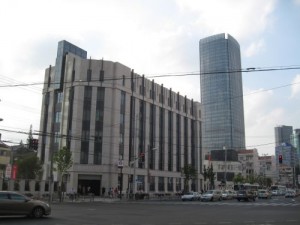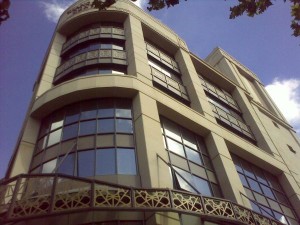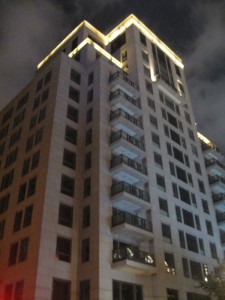
Shanghai Art Deco heritage has been rediscovered in the last 10 -15 years. After decades of neglect and many destructions in the great name of progress, old buildings facades have been renovated in the last year. Expo 2010 has not only been the opportunity for destructions (see post ‘Farewell to Shanghai General Hospital‘), it also has seen a number of renovations putting light on some of the architecture jewels (see post “somebody finally got it“). Most posts in this blog are focused on Shanghai past, particularly in the 1920’s and 1930’s. This post is a little deviation from the usual theme, focusing on Shanghai today’s architecture.

Shanghai original skyscraper boom took place in the late 1920’s – 1930’s, with a number of these buildings still remaining today like the Cathay Hotel (today Peace Hotel) on the Bund, Broadway Mansions on the Suzhou Creek and Grosvenor house on Maoming lu. The tallest building erected in that period was Park Hotel designed by Hungarian Architect Laszlo Hudec, 83.8 meters high with 22 stories. Park Hotel is a great art deco example, inspired by the Radiator Building in New York. It was the tallest building in Asia when it was built in 1934 and remained the tallest building in Shanghai until the 1980’s. From that point on, Shanghai new fashion became mostly white tiles looking just like a bathroom and blue (?) windows. Buildings from this period often look like a Frankenstein version of Art Deco, imitating the tiling and geometrical lines of the style but transforming it into something horrible. The next period was about glass and steel from the 1990’s followed by architecture wonders that are now all over LuJiaZui, the end of Nanjing Dong lu and other areas. Besides contemporary architecture of frameless glass bubbles, another style has been recently on the rise in specific parts of the city.

Limitations by law of the height of some building as well as renovation of older structures from the 1980’s as brought back an Art Deco inspiration to the city. As Shanghai Art Deco architecture was rediscovered, new architecture in the old areas was forced to fit in, using what is called fake art deco or fako. This is particularly true on the Bund where Peninsula as well as the brand new administration building next to the old Russo-Chinese bank were designed to match the surrounding style. Peninsula was allowed to dominate the Bund while still keeping an harmony with the neighboring buildings.
The other area is the old French Concession, where small concrete buildings that were real eye sores have been turned into fako buildings somehow matching the surrounding environment. I am not sure I like fako so much as I definitely prefer the original, but at least it is nice to have an harmony within an area. I have also seen a number of house complexes that are just like anyone else, except that they have some kind of art deco-ish decoration on top. I am much less a fan of those, but at least they keep some kind of atmosphere to Shanghai. The newly found Art Deco craze in Shanghai could be the perfect backdrop for an Art Deco festival like the one in Napier, New Zealand… though this is probably still very very far away.